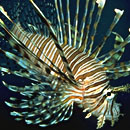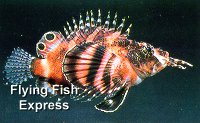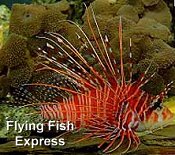

Lionfish go by many names; some call them Dragon Fish, some Turkey Fish, or Zebrafish, others Scorpion fish (which is the larger groupís name), and some--Red Firefish. However, in Maryland, just "Lionfish" seems to be the name of choice. These fish are from the Scorpaenidae family. There are over 300 species in the Lionfish family! They are predators, and so small live foods like live Rosy red minnows or Goldfish are very appreaciated every now and then. Shrimp and worms are also taken greedily. These are usually hardy fish if given what they need to thrive, and if the are eating and quarentined before adding to the display tank. They are only somewhat active, and rather peaceful. They Will swallow anything they can get into their very large mouths though, so beware!
These fish are posionous, but not so much as some other saltwater fish, like Rabbitfish. Still, the sting can be incredibly painful for quite a long period of time, so be careful when handling them needless to say. If you get stung, put your hand under very hot water for awhile and this greatly helps. Watch out if you are alleric to bee-stings, etc. Itís best to see a doctor, according to most sources, regardless. Remember, they can ambush you just like they can those feeder-fish!

The pectoral fins are greatly exlongated into those spines, creating an exotic and stunning display. They are used to trap small fish, like Damsels, in a corner. Also, they are obviously quite effective as a form of defense. The spiny dorsal rays may number up to 13. These fish will stand their ground more than many saltwater fish will.
Breeding has, sadly, not been accomplished in captivity, however we do know that the fish raise to the top, like most saltwater fish that are breeding, and "a gelantious ball of eggs is released. When they are 10-12mm, about a half inch, long--the fry sink to the bottom." (Quote from the Marine Aquarium from Tetra books).
There are many species offered for sale, from the Dwarf Lionfish, to the nocturnal Hawaiian Lion (Pterois sphex). Care is similar for most species. The main one that should be advoided is the Red Sea Dendrochirus Zebra (which actually can grow over 10 inches), and is very hard to keep and is called the Dwarf Zebra (not to be confused with the Dwarf Lionfish). The Hawaiian is the only decent canadite for a reef-tank, assuming it is specically setup for it (no small fish, sea urchins, etc.).
The Volitan is one of the most popular Lions offered for sale. They grow 1-1.5 feet long, therefore a tank of at least 100 gallons is needed. Most Lions should be kept in tanks 75 gallons and up, as the average Lion grows around 14 inches in most species. A 55 can sometimes be used though, as they are'nt the most active fish on the reefs.

The specfic gravity should be maintained a little high for most Lionfish, from 1.023-1.026. They are tolerant of pH, 8-8.5 is fine. They donít like Nitrate at all though, so keep up the water changes! Under 10ppm for Nitrate is the best for them. The main thing is stability, especially with salinty! So watch evaporation and so forth.
Lionfish are some of the most exotic fish on the reefs, and theyíre a great fish for the fish-only tank. Hoped this overview was interesting and helped.